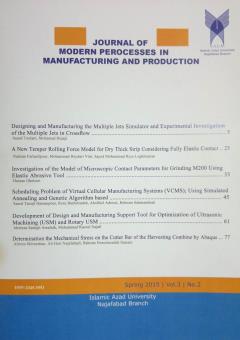Fabrication Feasibility of SU8 Waveguides and Gold Electrodes via Lift-Off-Based Micromachining Process
Subject Areas :
1 - Assistant Professor, Department of Electrical Engineering, Payame Noor University, Tehran, Iran
Keywords: Microfabrication, Lift-off, Photolithography, UV Exposure, Deposition, SU8,
Abstract :
Brain interfaces are advanced systems designed to combine optical waveguides for neural stimulation with electrodes for recording neural activity. The microfabrication process for developing such compact devices is challenging and critical to their performance and application. However, conventional fabrication techniques often involve stacking layers of different substrates for each of the stimulation and recording components, resulting in bulky designs that increase the risk of invasiveness. This issue makes the implants less practical for neuroscience studies. This research assesses a simple method for assembling SU8 waveguides with Au electrodes on a single substrate. It utilizes the lift-off technique to fabricate electrodes directly onto the waveguide, routing down to the same primary substrate. The introduced method eliminates the need for depositing additional layers as a base for electrode formation. The results demonstrated the successful feasibility and assembly of the structure without relying on a common stacked and thick configuration.
[1] Cabello, M., Domínguez, I., Macías, C., Perdigones, F., Aracil, C. and Quero, J. M. 2021. Low-cost SU-8 lift-off process to fabricate a Gold/Glass microelectrode array for culturing applications. Microsystem Technologies. 27(7): 3077–3081. doi: 10.1007/s00542-020-05206-9.
[2] Samanta, S., Banerji, P. and Ganguly, P. 2020. Experimental Studies on SU-8 Wire Waveguides. In: Photonic Waveguide Components on Silicon Substrate. SpringerBriefs in Applied Sciences and Technology. Springer, Singapore. doi: 10.1007/978-981-15-1311-4_3.
[3] Chen, Z., Li, X., Tang, Y., Huang, Z., Huang, J., Liu, H. and et al. 2024. Implantation-assistance-free flexible waveguide probe for optogenetic stimulation. Cell Reports Physical Science. 5(10). doi: 10.1016/j.xcrp.2024.102217.
[4] Chen, H.and Fang, Y. 2023. Recent developments in implantable neural probe technologies. MRS Bulletin. 48: 484–494. doi: 10.1557/s43577-023-00535-2.
[5] Luo, J., Xue, N. and Chen, J. 2022. A Review: research progress of neural probes for brain research and brain–computer interface. Biosensors. 12(12): 1167. doi: 10.3390/bios12121167.
[6] Shao, Q., Ma, X., Li, M. and He, J.-J. 2025. Thermo-tuning Fourier transform spectrometer based on SU-8 waveguide. Polymers. 17(3): 261. doi: 10.3390/polym17030261.
[7] Chen, Z. and Lee, J.-B. 2021. Biocompatibility of SU-8 and its biomedical device applications. Micromachines. 12(7): 794. doi: 10.3390/mi12070794.
[8] Lotfi Marchoubeh, M., Cobb, S.J., Abrego Tello, M. and et al. 2021. Miniaturized probe on polymer SU-8 with array of individually addressable microelectrodes for electrochemical analysis in neural and other biological tissues. Anal Bioanal Chem. 413: 6777–6791. doi: 10.1007/s00216-021-03327-2.
[9] Remy, A., Lin, X. and Liu, J. 2024. Materials for flexible and soft brain-computer interfaces, a review. MRS Communications. 14: 827–834. doi: 10.1557/s43579-024-00617-5.
[10] Mahmoudi, P., Veladi, H. and Pakdel, F.G. 2017. Optogenetics, tools and applications in neurobiology. J Med Signals Sens. 7(2):71-79.
[11] Mahmoudi, P., Veladi, H., Ghaderi Pakdel, F. and Frounchi, J. 2023. Low-cost optical splitter for neural stimulations using off-the-shelf ultraviolet adhesives (Erratum). Journal of Micro/Nanopatterning, Materials, and Metrology. 22(2): 029801. doi: 10.1117/1.JMM.22.2.029801.
[12] Mahmoudi, P. 2025. A review of patterned light delivery techniques in optogenetics: Scanning systems, modulators, and implants. Optoelectronic. 7(3): 57–87. doi: 10.30473/jphys.2025.73171.1225.

